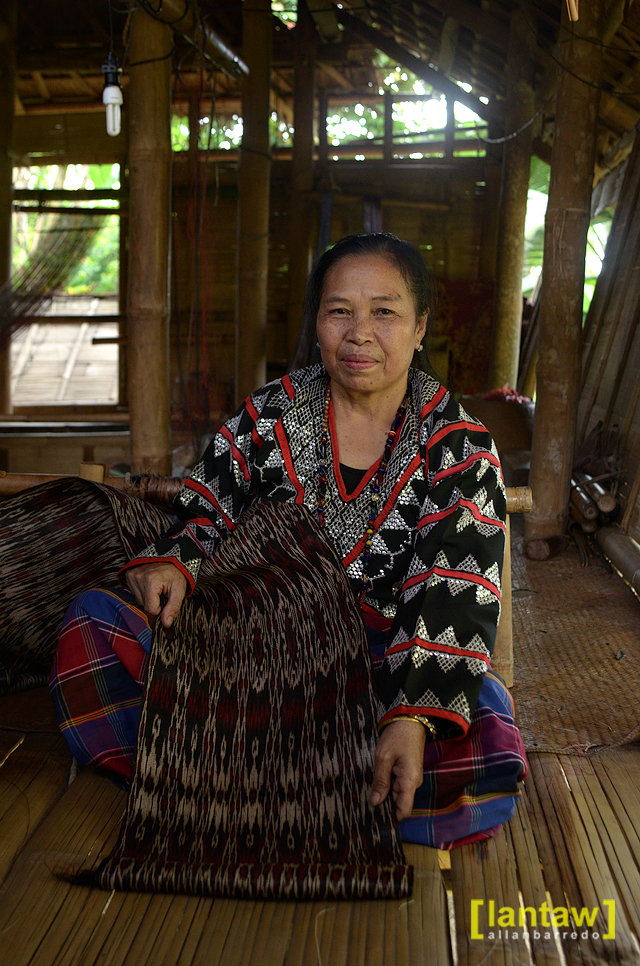If there is anything that can be considered as the centerpiece of the art and culture of the T’boli tribe in Mindanao, it would be the T’nalak cloth. Though the T’bolis are also skillful in other crafts such as embroidery, brass casting, malong weaving, T’nalak weaving has become most popular art form because it’s the one that’s unique to the tribe.
If you’ve been to this corner of the Philippines, you had probably noticed those coin purses or souvenir items made of “t’nalak” (the lowest quality if I may say so). Few people probably realize that the T’bolis actually consider the real T’nalak as sacred. It represents the dreams and the spiritual belief of the tribe. It is also made to commemorate an important event such as marriage or birth of a child.
The cloth takes months to make, and only the women of the tribe are allowed to weave it. The geometrical patterns they used are inspired by dreams, hence a master weaver, one who can interpret her dream and transform it into a pattern, is called a “dream weaver”. Though the patterns may be handed down from mother to daughter, each individual may have her own unique design as she progresses to be a true dream weaver. Some of the master dream weavers can have as many as a hundred unique designs.
The first stage of the process involves stripping the abaca plan to get the fibers. This may be the only part of the process that is being done by men.
abaca striping
Abaca tree is chopped. Only the middle trunk is used, the upper (near the leaves) and the lower parts are discarded. The outer layer is stripped, only the core (white portion) is used. The abaca is further shredded into finer strips using a simple device consisting of a blade mounted on a wooden frame The abaca is stripped down to thread-like thickness. These narrow strips are air-dried inside the house. These are later made into “tembong” – threads used for T’nalak weaving.
meticulous work of making tembong
The threads are made by attaching sections of fine strands of abaca to make long contiguous threads. There are two types of tembong: a thin one and a thicker thread (2-3 strips) that is used for horizontal weaving.
semdang
The next stage involves realigning good threads in preparation for designing. This process is called semdang. After this the basic T'nalak design is prepared. Portions of the threads that are not to be dyed black are masked. This stage is called mebed.
mebed
The dyeing process is called temugo. Black is used first and only unmasked portions are dyed. After that lime or “loho” is added to the boiling water when dyeing other portions red. Lime protects the black dye.
extracting red dye
Traditionally only natural dyes are used. For example, the leaves of a k’nalum tree are used for the dye. The thread is boiled for 10 days. The roots of a loko’ plant is grated and used as a red dye. Orange dye comes from the seeds of k’luga or annatto, green is from the leaves of lomus, brown is from the leaves and trunks of b’ayabas (native guava), and yellow from luyang-dilaw or turmeric.
boiling the threads with the dye
The threads are boiled with the dye for several days, 1-5 days depending on the color. Each day fresh grated roots or leaves are added to saturate the color.
bentol, putting design marker
Dyed threads are air dried and then prepared for actual weaving by putting design markers.
one of the youngest weavers
The weaving part takes a couple of months, depending on how complex the design is. During this period the weaver may practice abstinence to preserve the purity of her work.
lemubag
The process does not end with the weaving. After that the T'nalak is put through two final stages. Bumps are smoothened by hammering the T'nalak with a small wooden club.
smaki
The T'nalak is further smoothened using cowry shells. The final result is a thin and shiny T'nalak.
Not many young T'boli women nowadays have the skill to make exquisite T'nalak. Its a labor intensive process (and does not pay much) and most of the younger generation prefer to work in cities. But there are a few who still preserve the tradition handed down by several generation of women in their family.
Its sad to note that value of these works of art have also been diluted by commercialization. Cheap and very low quality "t'nalak" are mass produced to cater to the tourist crowd.


9 comments:
Sad to hear that there are "mass produced" t'nalak being sold already. I have 2 hanging on my wall that I bought some 4 years ago. They are beautiful.
Sad but true Jenn, the real value of the T'nalak is being diluted by these mass produced "t'nalak".
Even my own province have seem to forget what the T'nalak is all about. Thats why I am not fond of our "T'nalak Festival", it really not all about the T'nalak, just a bunch of merry making activities just to have a festival
Hi I'm Carmela,a student from UST and I'm also from South Cotabato. I just want to ask if I could use your photos for class presentation (Socio-cultural class). I'm presenting T'nalak but I don't have any images of the processes. I really wanted to introduce it here..although images are not necessary I still want to show everyone in my class how it's made other than just using description and I think your photos would really be a big help because it is well presented. I can't take them myself since I'm here in Manila.
@Carmela, email me at aebarredo[at]gmail.com
Hi, Teng here :). I am a fashion student currently on the verge of finding my personal aesthetics and been craving to see how this clothes are being made and longing to touch an authentic t'nalak fabric. My family originated from north cotabato and I would like to go to Lake Sebu, would you mind sharing how can I get to their place?
Hi Teng, once in Lake Sebu, you may head to COWHED (Women's Cooperative) near Punta Isla resort. You can look for Gemma and she can help you get in touch with some of the weavers.
Thank you :) hope to be there before the end of this year :)
Hi Allan, Congratulations for the awards you received for the past years. You definitely produced very good photos like the ones you captured to document our ILO Lake Sebu project. Regards.
by the way, Jenalyn Ipil is now managing COWHED. Gemma is now based in Surallah, I think. Regards to your wife.
Post a Comment